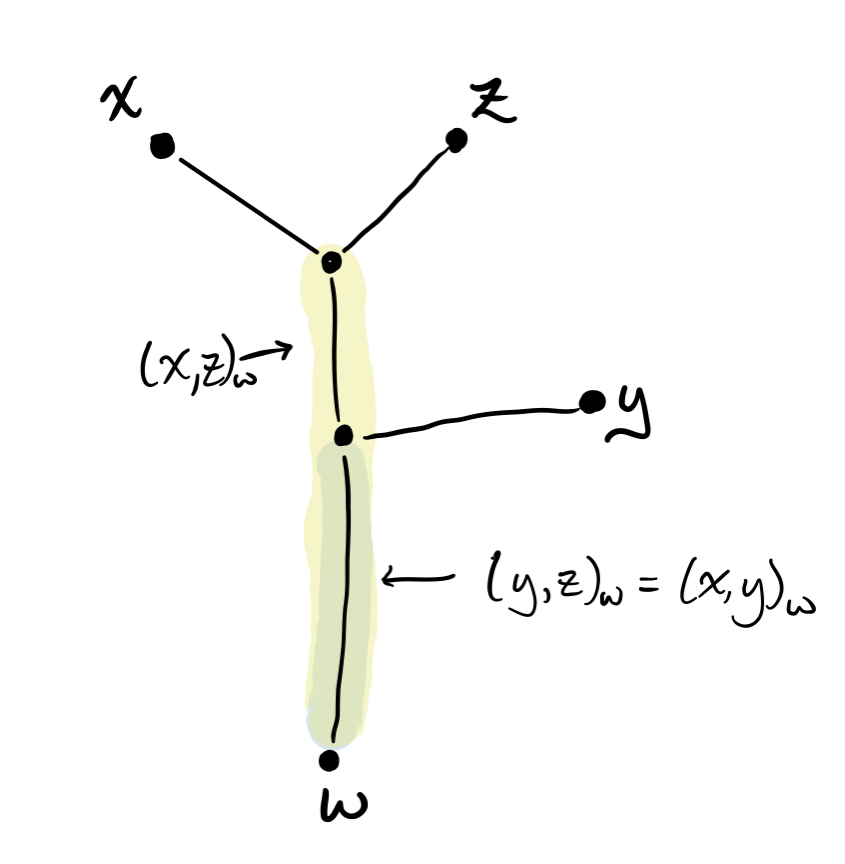Gromov’s original definition of Gromov hyperbolicity makes sense for arbitrary metric spaces. However, it is only a quasi-isometry invariant for geodesic metric spaces. I learned this from a paper of Väisälä. The purpose of this post is to understand the counterexample he gives. I also define Gromov hyperbolicity and quasi-isometry in this post, which might make it useful for future reference. The reader already familiar with Gromov hyperbolicity and quasi-isometries might wish to skip ahead to the heading below.
Let $(X,d)$ be a metric space. We say that $X$ is a length space if the distance between any two points $x$ and $y$ in $X$ is equal to the infimum of the length of a path joining them. A geodesic in $X$ is a path $\gamma\colon [a,b] \to X$ from a closed interval $[a,b] \subset \mathbb{R}$ such that $d(\gamma(s),\gamma(t)) = |s-t|$ for all $s$ and $t$ in the interval $[a,b]$ . We say that $X$ is a geodesic metric space if any two points can be joined by a geodesic. Geodesic metric spaces are length spaces but not necessarily conversely.
Gromov’s original definition of hyperbolicity of $X$ is the following. Given points $x$ , $y$ and $z$ in $X$ , define the Gromov product of $x$ and $y$ with respect to $z$ to be the quantity
$(x,y)_z = \frac{1}{2}\left(d(x,z) + d(y,z) - d(x,y)\right).$Then we say that $X$ is $\delta$ -hyperbolic if there exists some $\delta \ge 0$ with the property that for any four points $x$ , $y$ , $z$ and $w$ in $X$ , we have
$(x,z)_w \ge \min\{(x,y)_w,(y,z)_w\} - \delta.$Let’s try and make sense of this. The intuition for the Gromov product is the following. A tripod is a metric tree with four vertices, three of which are leaves and one of which has valence three. Given any triple of points $x$ , $y$ and $z$ in a metric space, you should convince yourself that we can always construct a tripod with leaves $\hat x$ , $\hat y$ and $\hat z$ such that we have
$d(x,y) = d(\hat x,\hat y),\quad d(x,z) = d(\hat x,\hat z),\quad\text{and}\quad d(y,z) = d(\hat y,\hat z).$In this situation, the Gromov product $(x,y)_z$ is equal to the distance from $\hat z$ to the center vertex of the tripod. To make sense of the hyperbolicity condition, let’s continue to think about trees, only in this case assume that $X$ itself is a metric tree. Then in this case it’s not too hard to argue that the hyperbolicity condition holds with $\delta = 0$ ; a picture illustrating the general case is below. Thus one way to think of $\delta$ -hyperbolicity is to think that from the point of view of any point $w \in X$ , triangles in $X$ look like triangles in trees, up to an error of $\delta$ .

If $X$ is a geodesic metric space, there are other conditions equivalent to this one that are more directly about the geometry of, e.g. triangles in $X$ . I’ve been collecting as many of these conditions as the community will give me in a MathOverflow post. Eventually I expect to make a blog post or several about the various definitions.
Given metric spaces $(X,d_X)$ and $(Y,d_Y)$ and constants $K \ge 1$ and $C \ge 0$ , a $(K,C)$ -quasi-isometric embedding is a function $f\colon X \to Y$ (it need not be continuous) such that for all points $x$ and $y$ in $X$ , the following inequality holds
$ \frac 1Kd_X(x,y) - C \le d_Y(f(x),f(y)) \le Kd_X(x,y) + C. $So we see that $f$ is allowed to distort distances by a bounded multiplicative and additive amount. A $(K,C)$ -quasi-isometry is a $(K,C)$ -quasi-isometric embedding with the additional property that for every point $y \in Y$ there is a point $x \in X$ such that $d_Y(y,f(x)) \le C$ .
The theorem and the counterexample
Väisälä proves the following theorem.
Theorem Let $X$ and $Y$ be length spaces and $f\colon X \to Y$ a quasi-isometric embedding. If $Y$ is $\delta$ -hyperbolic, then $X$ is $\delta'$ -hyperbolic for some $\delta'$ depending only on $\delta$ and the quasi-isometry constants for $f$ .
He then observes that the theorem is not true if one does not assume that $X$ is a length space. Here is the counterexample. The hyperbolic space $Y$ is the real line $\mathbb{R}$ with the standard metric. (Recall that $\mathbb{R}$ is a real tree, and thus $0$ -hyperbolic.) The space $X$ is the graph of the absolute value function $\{(x,y) \in \mathbb{R}^2 : y = |x| \}$ with the Euclidean metric. The claim is that the map $f\colon X \to Y$ defined as $f(x,y) = x$ is a quasi-isometric embedding, but that $X$ is not hyperbolic.
First we show that $f$ is a quasi-isometric embedding. Indeed, it is clear that given $\vec x$ and $\vec y$ in $X$ , we have $d_Y(f(\vec x),f(\vec y)) \le d_X(\vec x,\vec y)$ . On the other hand, note that $d_X(\vec x,\vec y)$ is furthest from $d_Y(f(\vec x),f(\vec y))$ when $\vec x$ and $\vec y$ are in the same quadrant, where we have $d_X(\vec x,\vec y) = \sqrt{2}d_Y(f(\vec x),f(\vec y))$ . Thus the map $f$ is a $(\sqrt 2,0)$ -quasi-isometric embedding, in fact a $(\sqrt 2,0)$ -quasi-isometry.
Finally we show that $X$ is not hyperbolic. Consider the four points $x = (0,0)$ , $y = (-2t,2t)$ , $z = (2t,2t)$ and $w = (t,t)$ . Then we have
$ (x,z)_w = \frac 12\left(\sqrt 2t + \sqrt 2t - 2\sqrt 2t\right) = 0,$ $ (x,y)_w = \frac 12\left(\sqrt 2t + 2\sqrt 5t - 2\sqrt 2t\right) \approx 1.53t$ $ (y,z)_w = \frac 12\left(2\sqrt 5t + \sqrt 2t - 4t\right) \approx 0.94t$But observe that as $t \to \infty$ , we have that $(x,y)_w$ and $(y,z)_w$ tend to $\infty$ , so no uniform choice of $\delta$ makes the inequality $(x,z)_w \ge \min\{(x,y)_w,(y,z)_w\} - \delta$ hold. The problem, roughly, is that the quasi-isometry condition cannot see the “kink” in the space $X$ , while the $\delta$ -hyperbolicity condition, at least for this family of triangles, can.